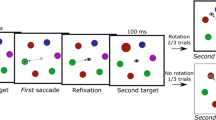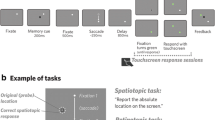Abstract
The eye movements we make to look at objects require that the spatial information contained in the object’s image on the retina be used to generate a motor command. This process is known as sensorimotor transformation and has been generally addressed using simple point targets. Here, we investigate the sensorimotor transformation involved in planning double saccade sequences directed at one or two objects. Using both visually guided saccades toward stationary objects and objects subjected to intrasaccadic displacements, and memory-guided saccades, we found that the coordinate transformations required to program the second saccade were different for saccades aimed at a new target object and saccades that scanned the same object. While saccades aimed at a new object were updated on the basis of the actual eye position, those that scanned the same object were performed with a fixed amplitude, irrespective of the actual eye position. Our findings demonstrate that different abstract representations of space are used in sensory-to-motor transformations, depending on what action is planned on the objects.




Similar content being viewed by others
References
Beauvillain C, Beauvillain P (1995) Calibration of an eye movement system for use in reading. BRMIC 27(3):331–337
Becker W, Fuchs AF (1969) Further properties of the human saccadic system: eye movements and correction saccades with and without visual fixation points. Vis Res 9:1247–1258
Becker W, Klein HM (1973) Accuracy of saccadic eye movements and maintenance of eccentric eye positions in the dark. Vis Res 13:1021–1034
Becker W, Jürgens R (1979) An analysis of the saccadic system by means of double step stimuli. Vis Res 19:967–983
Di Lollo V, Seiffert AE, Burchett G, Rabeeh R, Ruman TA (1997) Phosphor persistence of oscilloscopic displays: a comparison of four phosphors. Spat Vis 10(4):353–360
Ditterich J, Eggert T, Straube A (1998) Fixation errors and timing in sequences of memory-guided saccades. BBR 95:205–217
Duhamel JR, Colby CL, Goldberg ME (1992) The updating of the representation of visual space in parietal cortex by intended eye movements. Science 255:90–92
Findlay JM, Walker R (1999) A model of saccade generation based on parallel processing and competitive inhibition. Behav Brain Sci 22:661–721
Fuster J (1996) Frontal lobe and the cognitive foundation of behavioral action. In: Damasio A, Damasio H, Christen Y (eds) Neurobiology of decision-making. Springer, Berlin Heidelberg New York, pp 47–61
Gnadt JW, Andersen RA (1988) Memory related motor planning activity in posterior parietal cortex of macaque. Exp Brain Res 70:216–220
Goldberg ME, Bruce CJ (1990) Primate frontal eye fields, III: maintenance of a spatially accurate saccade signal. J Neurophysiol 64(2):489–508
Groner R, Groner MT, Müller P, Bischof WF, Di Lollo V (1993) On the confounding effects of phosphor persistence in oscilloscopic displays. Vis Res 33:913–918
Hallett PE, Lightstone AD (1976a) Saccadic eye movements to flashed targets. Vis Res 16:107–114
Hallett PE, Lightstone AD (1976b) Saccadic eye movements to stimuli triggered by prior saccades. Vis Res 16:99–106
Karn KS, Latcher J, Moller P, Hayhoe MM (1994) Task-dependent spatial memory across saccades. BBS 115:267–282
Karn KS, Moller P, Hayhoe MM (1997) Reference frames in saccadic targeting. Exp Brain Res 115:267–282
Mays LE, Sparks DL (1980a) Saccades are spatially, not retinocentrically coded. Science 208:1163–1165
Mays LE, Sparks DL (1980b) Dissociation of visual and saccade-related responses in superior colliculus neurons. J Neurophysiol 43:207–232
McConkie GW, Zola D (1987) Visual attention during eye fixations while reading. In: Coltheart M (ed) Attention and performance, vol 12. Erlbaum, London, pp 385–401
McConkie GW, Kerr PW, Reddix MD, Zola D (1988) Eye movement control during reading, I: the location of initial eye fixations on words. Vis Res 28(10):1107–1118
McConkie GW, Kerr PW, Reddix MD, Zola D, Jacobs AM (1989) Eye movement control during reading, II: frequency of refixation on a word. Percept Psych 46:245–253
McPeek RM, Skavenski AA, Nakayama K (2000) Concurrent processing of saccades in visual search. Vis Res 40:2499–2516
O’Regan JK (1990) Eye movements and reading. In: Kowler E (ed) Eye movements and their role in visual cognitive processes. Elsevier, Amsterdam, pp 395–453
O’Regan JK, Lévy-Schoen A, Pynte J, Brugaillière B (1984) Convenient fixation location within isolated words of different length and structure. J Exp Psychol Hum Percept Perform 10(2):250–257
Rayner K, Sereno SC, Raney GE (1996) Eye movement control in reading: a comparison of two types of models. J Exp Psychol Hum Percept Perform 22:1188–1200
Rayner K (1979) Eye guidance in reading: fixation locations within words. Perception 8:21–30
Robinson DA (1975) Oculomotor control signals. In: Lennerstand G, Bach-y-rita P (eds) Basics mechanisms of ocular motility and their clinical implications. Pergamon, Oxford, pp 337–374
Sparks DL (1986) Translation of sensory signals into commands for control of saccadic eye movements: role of primate superior colliculus. Physiol Rev 66:118–171
Theeuwes J, Kramer AF, Hahn S, Irwin DE (1998) Our eyes do not always go where we want them to go: capture of the eyes by new objects. Psychol Sci 9(5):379–385
Vergilino D, Beauvillain C (2000) The planning of refixation saccades in reading. Vis Res 40:3527–3538
Vergilino D, Beauvillain C (2001) Reference frames in reading: evidence from visually and memory-guided saccades. Vis Res 41:3547–3557
Vergilino-Perez D, Findlay JM (2003) Foveal stimulation and saccade latencies. Exp Brain Res 150:255–258
Vergilino-Perez D, Beauvillain C (2004) The ability of the saccadic system to change motor plans in scanning letter strings. Psych Bull Rev 11(2):332–337
Vergilino-Perez D, Findlay JM (2004) Object structure and saccade planning. Cogn Brain Res 20(3):525–528
Vitu F, O’Regan JK (1995) A challenge to current theories of eye movements in reading. In: Findlay JM, Kentridge RW, Walker R (eds) Eye movement research: mechanisms, processes and applications. North-Holland Press, Amsterdam, pp 381–392
Viviani P (1990) Eye movements in visual search: cognitive, perceptual and motor control aspects. In: Kowler E (ed) Eye movements and their role in visual and cognitive processes. Elsevier, Amsterdam, pp 353–391
Viviani P, Swensson RG (1982). Saccadic eye movements to peripherally discriminated visual targets. J Exp Psychol Hum Percept Perform 8(1):113–126
Viviani P, Velay JL (1987). Spatial coding of voluntary saccades in man. In: O’Regan JK, Levy-Schoen A (eds) Eye movements: from physiology to cognition. Elsevier, Amsterdam, pp 69–78
Wurtz RH, Goldberg ME (1972) Activity of superior colliculus in behaving monkey, III: cells discharging before eye movements. J Neurophysiol 35:575–586
Xing J, Andersen RA (2000) Memory activity of LIP neurons for sequential eye movements simulated with neural networks. J Neurophysiol 84:651–665
Zingale CM, Kowler E (1987) Planning sequences of saccades. Vis Res 27(8):1327–1341
Zipser D, Andersen RA (1988) A back propagation programmed network that stimulates response properties of a subset of posterior parietal neurons. Nature 331:679–681
Author information
Authors and Affiliations
Corresponding author
Rights and permissions
About this article
Cite this article
Beauvillain, C., Vergilino-Perez, D. & Dükic, T. Spatial object representation and its use in planning eye movements. Exp Brain Res 165, 315–327 (2005). https://doi.org/10.1007/s00221-005-2308-8
Received:
Accepted:
Published:
Issue Date:
DOI: https://doi.org/10.1007/s00221-005-2308-8




